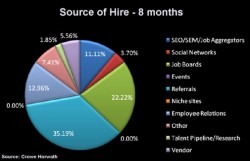Crowe Horwath has a social media strategy, a plan, and now evidence that its investment in social media recruiting is paying off.
 A just-completed mid-term report by Crowe Horwath’s strategic sourcing leader, Michele Porfilio, shows that in the first six months of the company’s fiscal year (which begins April 1) 20 percent of the hires came from non-traditional recruiting methods.
A just-completed mid-term report by Crowe Horwath’s strategic sourcing leader, Michele Porfilio, shows that in the first six months of the company’s fiscal year (which begins April 1) 20 percent of the hires came from non-traditional recruiting methods.
Those methods include search engine marketing and optimization, the use of job aggregators (principally Indeed and SimplyHired) and social networking sites such as Facebook, LinkedIn, and Twitter. For company purposes, those sources are grouped as either SEO/SEM/Job Aggregators or Social Networks.
The cost of the hires who came in through these sources is about a third of what the company spends on job boards.
“I would say,” Porfilio reports, “that overall, we’re getting better candidates from these social media sources and we have a much better ROI.”
Porfilio shared some of the findings from the report, which she prepared for the company’s Social Networking Advisory Council. Merely having such a group puts Crowe Horwath among the social media leaders. A CareerXroads survey of its mostly blue chip, Fortune list clients found fewer than half had a social media committee.
 The CareerXroads survey is more extensively discussed in a report on social media that will appear in the January issue of the Journal of Corporate Recruiting Leadership. The report focuses on how companies can inexpensively employ social media in their recruiting programs, and discusses the components of a social media recruiting strategy. Case studies are also presented on how Crowe Horwath and Hyatt Hotels use social media in their recruiting programs.
The CareerXroads survey is more extensively discussed in a report on social media that will appear in the January issue of the Journal of Corporate Recruiting Leadership. The report focuses on how companies can inexpensively employ social media in their recruiting programs, and discusses the components of a social media recruiting strategy. Case studies are also presented on how Crowe Horwath and Hyatt Hotels use social media in their recruiting programs.
Overall, she says, the percentage of candidates applying as a result of these non-traditional sources has more than doubled since 2009.
In an earlier conversation, before the report was completed, Porfilio said Crowe Horwath began developing a systematic social media strategy a year ago. For FY 2010, she estimates the company will spend about 30 percent of the recruiting budget on social media and networking sites as well as on optimizing the company’s jobs to make them more easily found on search engines.
 “The ROI from this,” she says now, after preparing the mid-term report, “is very good.”
“The ROI from this,” she says now, after preparing the mid-term report, “is very good.”
In two charts that include numbers through November, it’s clear enough that job boards may yield the most number of applicants by far, but employee referrals are the single biggest source (35 percent) of hires.
Job boards are next at 22 percent of hires. The two non-traditional categories together account for 15 percent. These two categories include search engine marketing and optimization, the use of job aggregators (principally Indeed and SimplyHired) and social networking sites such as Facebook, LinkedIn, and Twitter.
Social networking sites alone yielded almost 4 percent of the hires.
Though most of the dollar amounts are proprietary, Porfilio shared one data point from the report: About 5.5 percent of the hires at Crowe Horwath were sourced from Indeed.com. The cost of those hires averaged $1,600. That compares to an $8,500 cost of hire from one of the major job boards.
Even though, she says, she has “decreased my spend drastically in the job boards, there is still a need for them … Will we still be using Monster? Yes, until it becomes completely irrelevant, if that happens.”